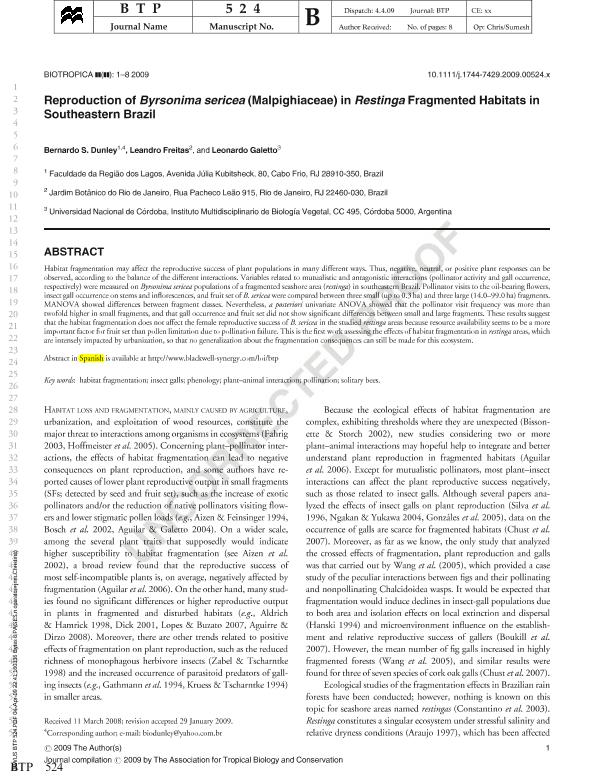Mostrar el registro sencillo del ítem
dc.contributor.author
Dunley, Bernardo S.
dc.contributor.author
Freitas, Leandro
dc.contributor.author
Galetto, Leonardo

dc.date.available
2017-07-14T17:20:54Z
dc.date.issued
2009-06
dc.identifier.citation
Dunley, Bernardo S.; Freitas, Leandro; Galetto, Leonardo; Reproduction of Byrsonima sericea (Malpighiaceae) in Restinga Fragmented Habitats in Southeastern Brazil; Wiley; Biotropica; 41; 6; 6-2009; 692-699
dc.identifier.issn
0006-3606
dc.identifier.uri
http://hdl.handle.net/11336/20583
dc.description.abstract
Habitat fragmentation may affect the reproductive success of plant populations in many different ways. Thus, negative, neutral, or positive plant responses can be observed, according to the balance of the different interactions. Variables related to mutualistic and antagonistic interactions (pollinator activity and gall occurrence, respectively) were measured on Byrsonima sericea populations of a fragmented seashore area (restinga) in southeastern Brazil. Pollinator visits to the oil-bearing flowers, insect gall occurrence on stems and inflorescences, and fruit set of B. sericea were compared between three small (up to 0.3 ha) and three large (14.0–99.0 ha) fragments. MANOVA showed differences between fragment classes. Nevertheless, a posteriori univariate ANOVA showed that the pollinator visit frequency was more than twofold higher in small fragments, and that gall occurrence and fruit set did not show significant differences between small and large fragments. These results suggest that the habitat fragmentation does not affect the female reproductive success of B. sericea in the studied restinga areas because resource availability seems to be a more important factor for fruit set than pollen limitation due to pollination failure. This is the first work assessing the effects of habitat fragmentation in restinga areas, which are intensely impacted by urbanization, so that no generalization about the fragmentation consequences can still be made for this ecosystem.
dc.format
application/pdf
dc.language.iso
eng
dc.publisher
Wiley

dc.rights
info:eu-repo/semantics/openAccess
dc.rights.uri
https://creativecommons.org/licenses/by-nc-sa/2.5/ar/
dc.subject
Fragmentacion
dc.subject
Reproduccion
dc.subject.classification
Ciencias de las Plantas, Botánica

dc.subject.classification
Ciencias Biológicas

dc.subject.classification
CIENCIAS NATURALES Y EXACTAS

dc.title
Reproduction of Byrsonima sericea (Malpighiaceae) in Restinga Fragmented Habitats in Southeastern Brazil
dc.type
info:eu-repo/semantics/article
dc.type
info:ar-repo/semantics/artículo
dc.type
info:eu-repo/semantics/publishedVersion
dc.date.updated
2017-07-13T18:26:26Z
dc.identifier.eissn
1744-7429
dc.journal.volume
41
dc.journal.number
6
dc.journal.pagination
692-699
dc.journal.pais
Estados Unidos

dc.journal.ciudad
Hoboken
dc.description.fil
Fil: Dunley, Bernardo S.. Faculdade da Região dos Lagos; Brasil
dc.description.fil
Fil: Freitas, Leandro. Jardim Botânico do Rio de Janeiro; Brasil
dc.description.fil
Fil: Galetto, Leonardo. Consejo Nacional de Investigaciones Científicas y Técnicas. Centro Científico Tecnológico Conicet - Córdoba. Instituto Multidisciplinario de Biología Vegetal. Universidad Nacional de Córdoba. Facultad de Ciencias Exactas Físicas y Naturales. Instituto Multidisciplinario de Biología Vegetal; Argentina
dc.journal.title
Biotropica

dc.relation.alternativeid
info:eu-repo/semantics/altIdentifier/doi/http://dx.doi.org/10.1111/j.1744-7429.2009.00524.x
dc.relation.alternativeid
info:eu-repo/semantics/altIdentifier/url/http://onlinelibrary.wiley.com/doi/10.1111/j.1744-7429.2009.00524.x/abstract
Archivos asociados
